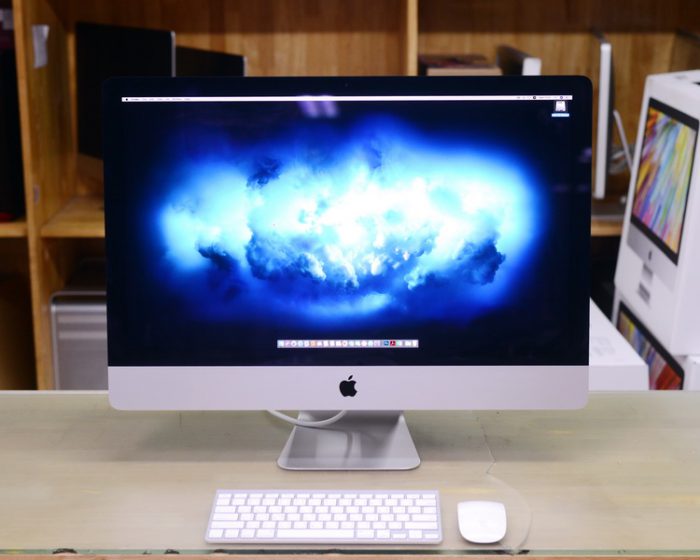

- Imac 27 late 2013 review pdf#
- Imac 27 late 2013 review update#
- Imac 27 late 2013 review pro#
- Imac 27 late 2013 review mac#
Imac 27 late 2013 review pro#
The upcoming “Vega” architecture looks promising, but it won’t be ready until the iMac Pro ships. That’s a problem in the iMac especially, since you can’t just add cooling capacity for the sake of boosting performance. The decision to choose AMD matters because, while its chips aren’t completely uncompetitive and offer a solid value for the price, they generally offer less performance per watt than contemporaneous GPUs from Nvidia. It comes with 2,304 shaders and 8GB of GDDR5 RAM on a 256-bit bus. And for the last few years, Apple has chosen AMD over Nvidia for its dedicated GPUs-the best GPU for the 2017 iMac is a Radeon Pro 580 chip based on the Polaris architecture, a jump forward from the “Tonga” architecture in the 20 5K iMacs. For one, it uses embedded laptop-class GPUs, which usually don’t go as fast as their desktop counterparts. GPU speeds still tend to increase more quickly than CPU speeds, but the iMac introduces some complications. GPU performance: From AMD to Nvidia and back again They come primarily from the results browsers for Primate Labs’ Geekbench and Kishonti’s GFXBench.
Imac 27 late 2013 review update#
We had the 20 iMacs on hand to test ourselves, but the recent update to our benchmark suite meant that we had to look elsewhere to gather some of the other figures.

The scores below were collected from a variety of sources. As much as these improvements helped make systems like the Retina MacBook and MacBook Pros possible, the chips in high-end iMacs improved only gradually. Some of those were more important than others, but the commonality they share is a focus on low-power chips and integrated graphics performance. CPU performance: Taking the Ivy Bridge to Kaby Lakeīetween 2012 and now, Intel has introduced four new CPU architectures. A lot has changed in five years, but how much faster have things really gotten? We’ll also get into the handful of technological updates Apple has made since the last new iMacs came out in late 2015. A typical replacement cycle in many businesses and schools is three or four years, and, as long as they don’t break, you can easily keep using them for years after that.Īpple has lent us its top-end 5K iMac to test, but instead of just sticking to year-over-year performance comparisons, we’ll be going all the way back to 2012 to compare it against some of the older iMacs that it might end up replacing (we’ve also included the 2011 iMac in a few cases, though it can’t run all of the benchmarks that newer iMacs can). Unlike phones and tablets, which can still post big performance gains from year to year, desktops age more slowly and gracefully.
Imac 27 late 2013 review mac#
But highly fine tuned colours are not the priority.Apple seems committed to the Mac Pro and iMac Pro for now, but the company says that its most popular desktops with pro users remains the 27-inch iMac. I'm fine downgrading a bit on speed and screen from my macbook, just don't want to feel like a massive step down. And I guess I could add an external SSD drive like kschendel said. But I'm very drawn to a 27" display and the processor on the imac seems better (?). I like the SSD drive on the mac mini and feel somewhat reassured by the newer model. I think both of them could be bargained down a little bit. iMac 27" late 2013, 3,5 GHz Intel Core i7, 8GB ram, 1TB fusion drive. mac mini 2014, i5 2.6 GHz, 16 GB ram, 256 SSD with an Apple LED Cinema display 24" - USD 1275 But I also found a relatively well spec-ed, newer mac mini with an external 24" display that I thought looked interesting. Given your responses, I'll go back to 2013 if the price looks decent and drives and ram can be upgraded. So I've had a rethink and I've decided to only look for 27". USD 702Īre the 2013 models too old to bother with? Here are some examples of machines I've seen (I'm in Norway, have converted the local prices): I've always used SSD so not sure how much of a difference to expect in speed. Most of them have a 'regular' 1TB hard drive.

So far, I've been looking at second hand options dating back to 2013. Not sure how I'd feel about that after being used to retina. Several of the second hand ones I've seen have a 1920x1080 screen. Need to play audio and video files for work, but no editing.
Imac 27 late 2013 review pdf#
Usage: I usually run about 10+ apps at the time: note taking app, calendar, two mail programs, pdf reader/editor, word, powerpoint, bookends, skype, omnioutliner, tidal, task manager, keyboard maestro. So far, I've kept my macbooks for a maximum of 4 years before upgrading. I'm unsure how far back it makes sense to go when buying used. I'm thinking of supplementing it with a second hand iMac for my office space at work, preferably a 27 inch but also looking at 21.


 0 kommentar(er)
0 kommentar(er)
